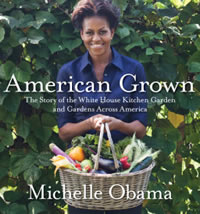 First Lady Michelle Obama’s new book, American Grown: The Story of the White House Kitchen Garden and Gardens Across America (Crown Publishers, 2012) has much to say about gardening as a learning process. A novice gardener, she doesn’t hesitate to admit that not all of the Kitchen Garden efforts succeeded on the first try: there were raised berms that succumbed to foot traffic and were replaced with untreated wooden boxes, troubles with cutworms, and trials and tribulations with pumpkins. But her motivation to create a food garden on the South Lawn with the participation of numerous horticulturists, chefs, and schoolchildren, has resulted in a beautiful, productive example for every aspiring urban farmer (even someone without a staff of dozens or a large growing space!).
First Lady Michelle Obama’s new book, American Grown: The Story of the White House Kitchen Garden and Gardens Across America (Crown Publishers, 2012) has much to say about gardening as a learning process. A novice gardener, she doesn’t hesitate to admit that not all of the Kitchen Garden efforts succeeded on the first try: there were raised berms that succumbed to foot traffic and were replaced with untreated wooden boxes, troubles with cutworms, and trials and tribulations with pumpkins. But her motivation to create a food garden on the South Lawn with the participation of numerous horticulturists, chefs, and schoolchildren, has resulted in a beautiful, productive example for every aspiring urban farmer (even someone without a staff of dozens or a large growing space!).
For readers who want to cultivate a closer relationship to the source of the food we eat (either by growing our own or by supporting small farms), this book is a good starting point. The book, which opens with a brief history of gardens at the White House, is arranged by season, and includes plans, descriptions of techniques and hands-on growing experiences, and recipes. Various experts on the garden staff contribute parts of the text. Seattle makes two appearances in the section on “How Our Gardens Grow Stronger Communities,” with a page on Picardo Farm P-Patch, and a historic photo of Pike Place Market. The book ends with a resource list and bibliography.
If you are curious about the source of initial hesitation/opposition to the first White House beehive ever, here’s a hint: the beehive is sited not far from the basketball court!
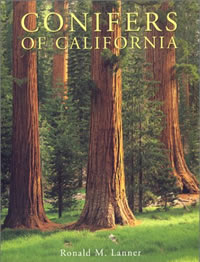 Conifers of California is a delightful introduction to many of our native conifers, as well as the incredible diversity of these cone bearing trees to be found further down the coast. Author Ronald M. Lanner writes what could be best described as a biography of each tree, telling the natural history and the interaction of each with humans and animals. While there are helpful descriptions, (including “At a distance”, “Standing beneath it”, and “In the hand”), this is not primarily a field guide.
Conifers of California is a delightful introduction to many of our native conifers, as well as the incredible diversity of these cone bearing trees to be found further down the coast. Author Ronald M. Lanner writes what could be best described as a biography of each tree, telling the natural history and the interaction of each with humans and animals. While there are helpful descriptions, (including “At a distance”, “Standing beneath it”, and “In the hand”), this is not primarily a field guide.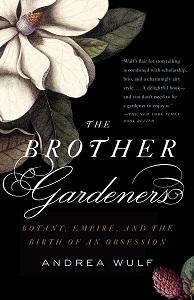 Andrea Wulf, in The Brother Gardeners, starts at the beginning of the 18th century. Up to that time gardening was “traditionally the preserve of the aristocracy…now, amateur gardeners began to take an obsessive interest in their smaller plots.” Her focus is on the transformation in England, but much of this was fueled by the interchange with American gardeners and particularly the importing of American plants to English gardens.
Andrea Wulf, in The Brother Gardeners, starts at the beginning of the 18th century. Up to that time gardening was “traditionally the preserve of the aristocracy…now, amateur gardeners began to take an obsessive interest in their smaller plots.” Her focus is on the transformation in England, but much of this was fueled by the interchange with American gardeners and particularly the importing of American plants to English gardens.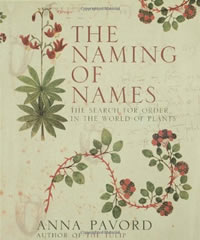 Anna Pavord’s The Naming of Names sets the groundwork for the system of nomenclature we use so freely today. More than just names, this book chronicles the development of human understanding of plants, how they live and propagate, but most importantly how we’ve come to identify and categorized them.
Anna Pavord’s The Naming of Names sets the groundwork for the system of nomenclature we use so freely today. More than just names, this book chronicles the development of human understanding of plants, how they live and propagate, but most importantly how we’ve come to identify and categorized them.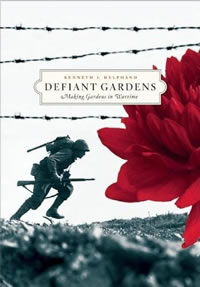 Defiant Gardens: Making Gardens in Wartime (2007) is not an easy book to read. The descriptions of the front lines, prison camps, Jewish ghettos, and Japanese internment camps from the first half of the 20th century are brutal, detailed, and very unsettling.
Defiant Gardens: Making Gardens in Wartime (2007) is not an easy book to read. The descriptions of the front lines, prison camps, Jewish ghettos, and Japanese internment camps from the first half of the 20th century are brutal, detailed, and very unsettling.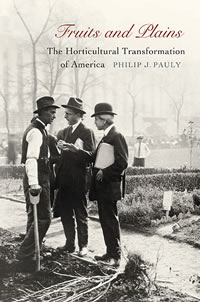 Philip Pauly was a professor of history at Rutgers University. His book, Fruits and Plains , was published by Harvard University Press. These are high academic credentials for a book that at first glance appears to be about gardening. But this is no ordinary gardening book. As suggested by the sub-title, The Horticultural Transformation of America, this is a serious study of the importance of horticulture to all aspects of American life particularly from the founding of the country well into the 20th century.
Philip Pauly was a professor of history at Rutgers University. His book, Fruits and Plains , was published by Harvard University Press. These are high academic credentials for a book that at first glance appears to be about gardening. But this is no ordinary gardening book. As suggested by the sub-title, The Horticultural Transformation of America, this is a serious study of the importance of horticulture to all aspects of American life particularly from the founding of the country well into the 20th century.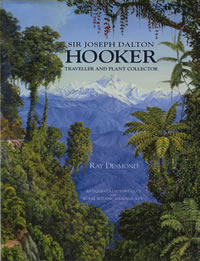 Sir Joseph Dalton Hooker: Traveler and Plant Collector (2001) by Ray Desmond is a marvelous travelogue, masking as a biography. Our hero took two multi-year expeditions (to Antarctica, New Zealand, and Australia from 1839-1843; and to India and the Himalayas from 1847-1851) as well as shorter trips to Morocco, Palestine, and the United States.
Sir Joseph Dalton Hooker: Traveler and Plant Collector (2001) by Ray Desmond is a marvelous travelogue, masking as a biography. Our hero took two multi-year expeditions (to Antarctica, New Zealand, and Australia from 1839-1843; and to India and the Himalayas from 1847-1851) as well as shorter trips to Morocco, Palestine, and the United States. Cottonwood and the River of Time by Reinhard Stettler explores an unlikely topic, cottonwood trees and their kin including poplars and aspens. A retired University of Washington professor of forestry, the author writes an engaging natural history beginning with a single tree, an old matriarch near the Snoqualmie River. While eventually global in scope, many of the examples continue to be set in the Pacific Northwest.
Cottonwood and the River of Time by Reinhard Stettler explores an unlikely topic, cottonwood trees and their kin including poplars and aspens. A retired University of Washington professor of forestry, the author writes an engaging natural history beginning with a single tree, an old matriarch near the Snoqualmie River. While eventually global in scope, many of the examples continue to be set in the Pacific Northwest.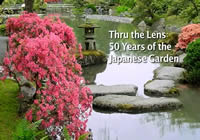 Thru the lens: 50 years of the Japanese Garden is a nearly hour-long documentary on DVD that explores both the history and current activities in the garden. Several docents, gardeners, and supporters are interviewed. I found the in-depth presentation of the tea ceremony particularly interesting. This documentary has a limited availability, but can be viewed with headsets at the Miller Library.
Thru the lens: 50 years of the Japanese Garden is a nearly hour-long documentary on DVD that explores both the history and current activities in the garden. Several docents, gardeners, and supporters are interviewed. I found the in-depth presentation of the tea ceremony particularly interesting. This documentary has a limited availability, but can be viewed with headsets at the Miller Library.